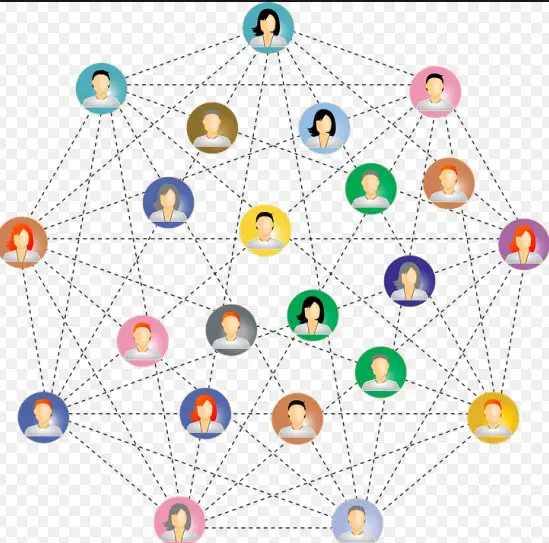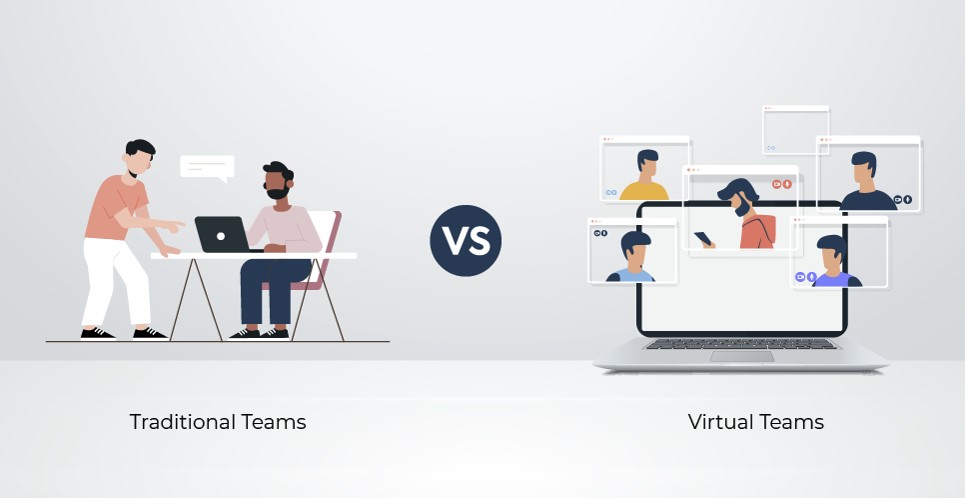The work environment is undergoing a significant transformation, evolving from traditional, office-bound team structures to more dynamic, virtual formats. This shift is largely driven by advancements in technology and a growing need for flexibility in the way we work. The comparison between virtual and traditional teams reveals deep-seated differences that impact how organizations operate, communicate, and succeed in today’s global marketplace.
Virtual teams operate remotely, leveraging digital communication tools to collaborate across different locations and time zones, offering benefits like greater flexibility and access to a broader talent pool. Traditional teams, on the other hand, are characterized by their physical presence in a shared location, facilitating direct interaction and communication. The primary distinction lies in the mode of operation and communication, influencing factors such as team cohesion, productivity, and operational costs.
As the landscape of work continues to evolve, understanding the nuances of virtual and traditional teams becomes crucial for businesses aiming to navigate the complexities of modern workforce management. This knowledge is not only essential for making informed decisions about team structure but also for leveraging the unique advantages each model offers to achieve organizational goals.

Virtual Teams Defined
Essentials of Virtual Teams
In today’s digitally connected world, the concept of virtual teams has become a cornerstone for many organizations aiming to leverage the power of technology to enhance their operations. A virtual team refers to a group of individuals who work together from different geographical locations, relying on electronic communication to collaborate. These teams are characterized by their diverse geographic distribution, digital communication, and flexibility, which allow them to operate beyond the confines of traditional office spaces.
Key characteristics that define virtual teams include:
- Remote Work: Team members work from various locations, which can be anywhere in the world.
- Digital Tools: Utilization of email, video conferencing, project management software, and other digital tools to facilitate communication and collaboration.
- Flexible Schedules: The ability to work according to individual schedules, accommodating different time zones and personal commitments.
Benefits of Virtual Teams
Virtual teams offer several advantages that are particularly appealing in the current global business environment:
- Flexibility: Team members can work from anywhere, providing a balance between work and personal life.
- Global Talent Access: Companies are not limited by geographical boundaries, enabling them to recruit the best talent from around the world.
- Reduced Overhead Costs: With no need for physical office space, companies can save on rent, utilities, and other related expenses.
However, the success of virtual teams hinges on the effective use of technology and the ability to maintain clear communication and strong team dynamics.
Challenges of Virtual Teams
Despite their benefits, virtual teams face several challenges that can impede their effectiveness:
- Communication Barriers: Without face-to-face interaction, miscommunications are more likely. Relying solely on digital communication can lead to a lack of clarity.
- Time Zone Differences: Coordinating across multiple time zones requires significant scheduling flexibility and can delay decision-making processes.
- Team Cohesion: Building a strong team culture and ensuring cohesive teamwork is challenging when personal interactions are limited.
Addressing these challenges requires a proactive approach, focusing on communication strategies, technology solutions, and team-building activities.
Traditional Teams Explained
Core Aspects of Traditional Teams
Contrasting with virtual teams, traditional teams are rooted in physical co-location and direct interaction. These teams operate within a shared office environment, where members can collaborate and communicate face-to-face. The core elements of traditional teams include:
- Shared Physical Space: Team members work in the same location, enhancing immediate communication and collaboration.
- Direct Communication: The ability to have spontaneous discussions and meetings without the need for digital mediation.
- Structured Work Hours: Working hours are typically fixed, aligning with the standard office operation times.
Advantages of Traditional Teams
The benefits of traditional teams stem from their structure and operation mode:
- Immediate Communication: Face-to-face interactions facilitate clearer communication and quicker resolution of issues.
- Stronger Team Bonds: Physical proximity helps in building personal relationships and a sense of community within the team.
- Ease of Supervision: Managers can more easily oversee team activities and provide immediate feedback.
These advantages highlight the value of direct interaction and structured environments in fostering team dynamics and productivity.
Drawbacks of Traditional Teams
Despite their benefits, traditional teams face limitations that can affect their operation and efficiency:
- Higher Operational Costs: Maintaining office space and resources requires significant financial investment.
- Geographical Talent Restrictions: Companies are limited to hiring talent that is available locally or willing to relocate.
- Inflexibility in Work Arrangements: The requirement to be physically present in an office can restrict the flexibility in work schedules and arrangements.
Overcoming these drawbacks often involves adapting new technologies and considering flexible work arrangements to enhance the traditional team model.
Key Differences
Communication Dynamics
The communication dynamics of virtual and traditional teams are starkly different, primarily due to the medium through which interactions occur. In virtual teams, communication is facilitated through digital channels like emails, chat applications, and video conferencing. This mode of communication, while flexible, often requires more effort to ensure clarity and prevent misunderstandings. Traditional teams benefit from face-to-face interactions, where non-verbal cues and immediate feedback can greatly enhance understanding and efficiency.
- Virtual teams might face delays in communication due to time zone differences, requiring asynchronous communication strategies.
- Traditional teams enjoy the advantage of spontaneous discussions, fostering quicker decision-making and problem-solving.
Team Cohesion and Culture
Building a cohesive team culture is a challenge for both virtual and traditional teams, albeit for different reasons. Virtual teams need to overcome the physical distance to foster a sense of belonging and shared purpose among their members. They often rely on virtual team-building activities and regular check-ins to create a cohesive culture. Traditional teams, on the other hand, can leverage their physical presence to strengthen bonds through informal interactions and social activities within the office environment. However, they may struggle with inclusivity if not managed carefully.
- Virtual teams can harness creative online team-building exercises to enhance team spirit.
- Traditional teams may organize in-person events and collaborative projects to strengthen team dynamics.
Productivity and Efficiency
The debate on productivity and efficiency between virtual and traditional teams is nuanced, with several factors at play. Virtual teams offer the flexibility to work during hours that suit individual peak productivity times, potentially leading to higher efficiency. However, they may also face distractions from the home environment. Traditional teams benefit from a structured work environment but may encounter productivity dips due to commuting stress and rigid schedules.
- Distraction management strategies are crucial for virtual teams to maintain productivity.
- Traditional teams might implement flexible work arrangements to enhance efficiency.
Talent Acquisition and Diversity
Virtual and traditional teams have different impacts on talent acquisition and diversity. Virtual teams provide access to a global talent pool, making it easier to build diverse teams that bring a wide range of perspectives and skills. This diversity can lead to more innovative solutions and a broader understanding of global markets. Traditional teams might be limited to local talent, potentially reducing diversity but benefiting from easier integration into the company culture.
- Virtual teams need to focus on inclusive practices to fully benefit from their diverse makeup.
- Traditional teams could expand their talent search through remote work options for certain roles.
Cost Implications
Evaluating the cost-effectiveness of virtual versus traditional teams involves considering both direct and indirect costs. Virtual teams can significantly reduce overhead costs related to physical office spaces and utilities. However, they may incur costs associated with technology and cybersecurity measures. Traditional teams face higher costs for office maintenance but can save on technology investments.
- Virtual teams should invest in secure and efficient technology to support remote work.
- Traditional teams might explore co-working spaces to reduce overhead costs.
Transition Strategies
For Virtual Teams
Transitioning to a virtual team model requires strategic planning and investment in technology. Key strategies include:
- Selecting robust collaboration tools to ensure seamless communication and project management.
- Developing clear communication protocols to prevent misunderstandings and ensure that all team members are on the same page.
- Fostering a strong online team culture through regular virtual meet-ups and team-building activities.
For Traditional Teams
Maintaining or enhancing traditional teams also involves embracing innovation and flexibility:
- Implementing hybrid work arrangements can offer employees the benefits of both models.
- Investing in technology to facilitate occasional remote work and enhance productivity.
- Encouraging open communication and regular feedback to strengthen team cohesion and adapt to changes.
Future of Work
Trends and Predictions
The future of work is likely to see an increasing blend of virtual and traditional team models. Hybrid models are becoming more popular, offering flexibility while retaining the benefits of face-to-face interaction. Advancements in technology will continue to shape how teams collaborate and operate, making remote work more feasible and efficient.
- The rise of digital nomadism and flexible work policies are trends that highlight the shifting dynamics of the workplace.
Embracing Hybrid Models
Hybrid models represent a balanced approach, combining the best aspects of virtual and traditional teams. These models can enhance employee satisfaction, reduce costs, and increase productivity. Successfully implementing a hybrid model requires careful consideration of team dynamics, work processes, and technology infrastructure.
Frequently Asked Questions
What makes virtual teams different from traditional teams?
Virtual teams differ from traditional teams mainly in their mode of operation and communication. Virtual teams work remotely, often across various time zones, and rely heavily on digital communication and collaboration tools. This setup offers flexibility and access to a global talent pool, whereas traditional teams work from a common physical location, benefiting from direct, face-to-face interaction and communication.
How do communication dynamics vary between virtual and traditional teams?
Communication dynamics in virtual teams are primarily mediated through technology, which can lead to challenges in maintaining clarity and ensuring effective teamwork. Traditional teams benefit from immediate face-to-face communication, which can enhance understanding and foster stronger interpersonal relationships. However, virtual teams often develop innovative communication strategies to overcome these barriers.
Can virtual teams be as productive as traditional teams?
Yes, virtual teams can be as productive as traditional teams, and sometimes even more so. The key to productivity in virtual teams lies in the effective use of technology, clear communication, and well-defined work processes. Flexibility and the ability to work from anywhere can also lead to increased productivity and job satisfaction for many individuals.
What are the cost implications of virtual vs. traditional teams?
Virtual teams can significantly reduce overhead costs related to physical office spaces, utilities, and commuting. However, investments in technology and digital tools are crucial for effective operation. Traditional teams incur higher costs due to the necessity of a physical workspace but may save on technology investments. The choice between virtual and traditional setups depends on the specific needs and resources of the organization.
Conclusion
The debate between virtual and traditional teams is not about declaring a definitive winner but understanding how each model fits within the unique context of an organization’s goals, culture, and workforce needs. As the digital landscape expands, the ability to adapt and leverage the strengths of both virtual and traditional teams becomes a significant competitive advantage.
In a world where the only constant is change, flexibility, and adaptability in team structures offer the resilience needed to navigate the challenges of the modern workplace. Organizations that understand and embrace the dynamics of both virtual and traditional teams will be better positioned to thrive in the evolving landscape of work, harnessing diversity, innovation, and efficiency to drive success.

